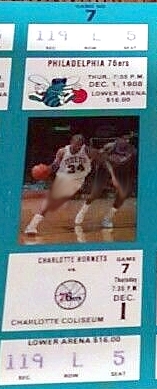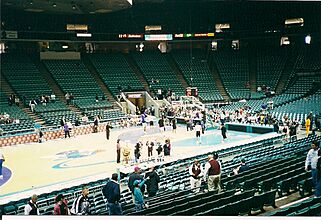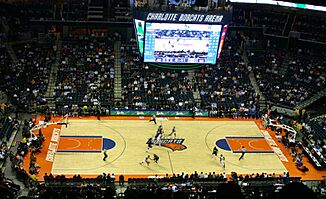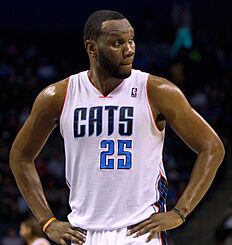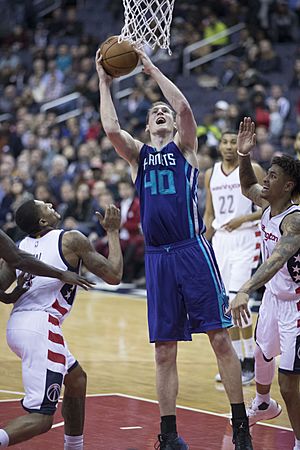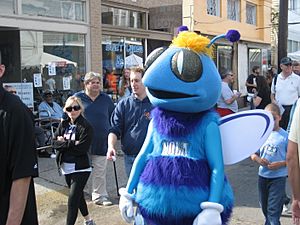Charlotte Hornets facts for kids
Quick facts for kids Charlotte Hornets |
|||
|---|---|---|---|
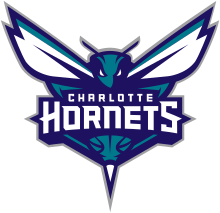 |
|||
| Conference | Eastern | ||
| Division | Southeast | ||
| Founded | 1988 | ||
| History | Charlotte Hornets 1988–2002, 2014–present Charlotte Bobcats 2004–2014 |
||
| Arena | Spectrum Center | ||
| Location | Charlotte, North Carolina | ||
| Team colors | Teal, dark purple, gray, white |
||
| Main sponsor | None | ||
| President | Shelly Cayette-Weston | ||
| General manager | Jeff Peterson | ||
| Head coach | Charles Lee | ||
| Ownership | Gabe Plotkin & Rick Schnall (majority) Eric Church, J Cole, and Michael Jordan (minority) |
||
| Affiliation(s) | Greensboro Swarm | ||
| Championships | 0 | ||
| Conference titles | 0 | ||
| Division titles | 0 | ||
| Retired numbers | 1 (13) | ||
|
|||
The Charlotte Hornets are a professional basketball team from Charlotte, North Carolina. They play in the National Basketball Association (NBA). The Hornets are part of the Eastern Conference and compete in the Southeast Division. Their home games are played at the Spectrum Center.
The Charlotte Hornets team started in 1988 as a new team, owned by George Shinn. In 2002, the team moved to New Orleans. For a short time, Charlotte did not have an NBA team.
The team returned as the Charlotte Bobcats in the 2004–05 NBA season. On June 15, 2006, basketball legend Michael Jordan bought a small part of the team. He also started to manage their basketball operations. By February 17, 2010, Jordan's group owned most of the team. In 2013, the Bobcats announced they would change their name back to the Charlotte Hornets for the 2014–15 season.
In August 2023, Michael Jordan sold most of his share in the Hornets. A group of investors led by Gabe Plotkin and Rick Schnall bought it. Jordan still owns a small part of the team.
Contents
- History
- Starting the Team: The Hornets are Born (1985–1988)
- First Seasons: Learning the Ropes (1988–1992)
- Star Players: Johnson and Mourning (1992–1995)
- The Glen Rice Era (1995–1998)
- Original Team's Final Years (1998–2002)
- The Charlotte Bobcats (2004–2014)
- Return of the Hornets & Key Players (2014–2020)
- The LaMelo Ball Era (2020–Present)
- Logos and Uniforms
- Performance Record
- Arenas
- Team Personnel
- Head Coaches
- Team Records and Awards
- Mascot and Cheerleaders
- Media Coverage
- See also
History
Starting the Team: The Hornets are Born (1985–1988)
In 1985, the NBA planned to add new teams. George Shinn, a businessman from North Carolina, wanted to bring an NBA team to Charlotte. Charlotte was growing fast and loved college basketball.
Shinn's big advantage was the Charlotte Coliseum. This arena could hold almost 24,000 fans. It was the biggest basketball arena ever for an NBA team. On April 5, 1987, the NBA chose Charlotte to get a new team. The team would start playing in 1988. Other new teams were Miami, Minneapolis–Saint Paul, and Orlando.
The team was almost called the "Charlotte Spirit." But a contest to name the team picked "Hornets." This name came from a British general who called Charlotte "a hornet's nest of rebellion" long ago. The team chose teal as its main color, which became very popular. Their uniforms, designed by Alexander Julian, were the first in the NBA to have pin stripes.
Carl Scheer became the team's first President and General Manager. He wanted experienced players to make the team competitive right away. Dick Harter was hired as the first head coach. In 1988, the Hornets picked players in the 1988 NBA expansion draft and the 1988 NBA draft.
First Seasons: Learning the Ropes (1988–1992)
The Hornets played their first NBA game on November 4, 1988. They lost to the Cleveland Cavaliers. Four days later, they won their first game against the Los Angeles Clippers. On December 23, 1988, the Hornets beat Michael Jordan and the Chicago Bulls. The Hornets finished their first season with 20 wins and 62 losses.
Even though the Coliseum was huge, the Hornets were very popular. They led the NBA in attendance many times. They even sold out 364 games in a row!
The second season was tough. Coach Dick Harter was replaced by Gene Littles mid-season. The team finished with 19 wins and 63 losses.
The team got a little better in the next season. They hosted the 1991 NBA All-Star Game. They finished with 26 wins and 56 losses. Gene Littles was fired, and Allan Bristow became the new general manager.
In the 1991 NBA draft, the Hornets picked Larry Johnson. He had a great first year, scoring many points and grabbing many rebounds. He won the 1992 NBA Rookie of the Year Award. The team finished with 31 wins and 51 losses.
Star Players: Johnson and Mourning (1992–1995)
In the 1992 NBA draft, the Hornets picked Alonzo Mourning. With Johnson, Mourning, and Kendall Gill, the team had a strong young group. In their fifth season, they had their first winning record (44–38). They made the playoffs for the first time! They beat the Boston Celtics in the first round. But they lost to the New York Knicks in the next round.
The next season, the Hornets finished 41–41 and just missed the playoffs. In the 1994–95 season, they had a 50–32 record and made the playoffs again. But they lost to the Chicago Bulls in the first round. After that season, the Hornets traded Alonzo Mourning to the Miami Heat. They got Glen Rice, Matt Geiger, and Khalid Reeves in return.
The Glen Rice Era (1995–1998)
Glen Rice quickly became a top scorer for the Hornets. With Rice and Johnson, the team had strong offense. They finished the 1995–96 season with a 41–41 record and missed the playoffs. Allan Bristow left, and Dave Cowens became the new coach.
In 1996, the team made more big changes. They traded Larry Johnson for Anthony Mason. They also traded the draft rights to Kobe Bryant for Vlade Divac. The new team did very well, finishing the 1996–97 season with a 54–28 record. They made the playoffs but lost to the Knicks.
The 1997–98 season was also good. The team traded Muggsy Bogues and got David Wesley and Bobby Phills. With these players, the Hornets finished 51–31. They made the playoffs again, reaching the second round, but lost to the Bulls.
Original Team's Final Years (1998–2002)
The 1998–99 season was shorter because of a player lockout. Glen Rice was traded for Eddie Jones and Elden Campbell. Coach Dave Cowens left, and Paul Silas took over. The team finished 26–24 and missed the playoffs.
For the next three seasons (1999–2002), the Hornets made the playoffs every year. They reached the conference semifinals twice. But before the 2002 playoffs ended, the NBA allowed the team to move to New Orleans. This move happened because fewer fans were coming to games, partly due to the owner's declining popularity.
The Charlotte Bobcats (2004–2014)
After the team moved, the NBA decided to bring a new team to Charlotte. This was part of a deal with the city. On December 18, 2002, a group led by Robert L. Johnson was chosen to own the new team. He became the first African American majority owner in major U.S. sports. Hip-hop artist Nelly also became a co-owner.
In June 2003, the new team was named the Bobcats. The name "Bobcats" was chosen partly because Charlotte already had a cat-named team, the Carolina Panthers (NFL).
The Bobcats hired Bernie Bickerstaff as their first head coach and general manager. A new arena, the Charlotte Bobcats Arena, started being built in 2003. The team played at the old Coliseum until the new arena was ready.
Returning to Charlotte (2004–2010)
The Bobcats picked players in their expansion draft on June 22, 2004. They also traded for the second pick in the 2004 NBA draft and chose Emeka Okafor. The Bobcats' first game was on November 4, 2004, a loss to the Washington Wizards. Two days later, they won their first game against the Orlando Magic. They finished their first season with 18 wins and 64 losses. Emeka Okafor won the 2004–05 NBA Rookie of the Year Award.
In their second season, the Bobcats opened their new arena. They finished with 26 wins and 56 losses, an improvement. After the season, Michael Jordan bought a small part of the team and became head of basketball operations.
The Bobcats improved in the 2006–07 season, finishing 33–49. On June 3, 2007, the old Charlotte Coliseum was torn down.

In 2007, Rod Higgins became general manager, and Sam Vincent became the new head coach. The team finished the 2007–08 season with 32 wins and 50 losses. Sam Vincent was fired in April 2008.
On April 29, 2008, Larry Brown became the new head coach. The team got close to making the playoffs in the 2008–09 season, finishing 35–47. In February 2010, it was announced that Michael Jordan would buy the team. He became the first former NBA player to own most of a team.
On April 9, 2010, the Bobcats made the playoffs for the first time! They finished the 2009–10 season with a winning record of 44–38. Gerald Wallace became the Bobcats' first and only NBA All-Star. However, the Bobcats lost to the Orlando Magic in four games in the playoffs.
Final Years as Bobcats (2010–2014)
After a tough start to the 2010–11 season, Larry Brown stepped down as head coach. Paul Silas took over. The team traded Gerald Wallace and finished with 34 wins and 48 losses.

In the 2011 NBA draft, the Bobcats picked Bismack Biyombo and Kemba Walker. The 2011–12 NBA season was shorter due to a lockout. Charlotte had a very bad season, losing their last 23 games. They finished with only 7 wins and 59 losses, setting a record for the worst winning percentage in NBA history. Paul Silas was not brought back as coach. Mike Dunlap became the new coach.
In the 2012 NBA draft, the Bobcats picked Michael Kidd-Gilchrist. They started the 2012–13 NBA season well with a 7–5 record. But then they lost 18 games in a row. They finished 21–61. Mike Dunlap was fired, and Steve Clifford became the new coach.
In the 2013 NBA draft, the Bobcats picked Cody Zeller. They also signed Al Jefferson. The new players and coach helped the team. The Bobcats made the playoffs for the second time in their history, finishing 43–39. But they were swept by the defending champion Miami Heat in the first round.
Return of the Hornets & Key Players (2014–2020)
The Hornets are Back!
On May 21, 2013, Michael Jordan announced the team wanted to change its name back to the Charlotte Hornets. The NBA approved this on July 18, 2013. The change happened after the 2013–14 season.
The Bobcats announced they would use a new version of the original Hornets' teal, purple, and white colors. They also added black, gray, and Carolina blue. The team showed off its new logo and started the "Buzz City" campaign. On May 20, 2014, the Bobcats officially became the Charlotte Hornets again.
As part of the name change, the Hornets got back the history and records of the original 1988–2002 Hornets team. The New Orleans team kept the records from their time as the Hornets (2002–2013). This means the Charlotte Hornets are now seen as having paused operations from 2002 to 2004.
Playoffs and Challenges (2014–2019)
In the 2014 NBA draft, the Hornets picked Noah Vonleh. They also signed Lance Stephenson and Marvin Williams. Their first year back as the Hornets was tough, finishing 33–49.
The next year, the team got much better, finishing 48–34. This was their best season since the original Hornets era. They made the playoffs again but lost to the Miami Heat in seven games. They won two playoff games at home, their first playoff wins since the original Hornets.
After that season, some players left, but the Hornets re-signed Nicolas Batum and Marvin Williams. Kemba Walker was chosen for his first All-Star Game. The Hornets finished the 2016–17 NBA season with a 36–46 record and missed the playoffs.
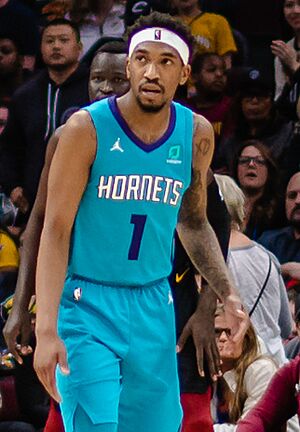
In 2017, the Hornets traded for Dwight Howard. They also picked Malik Monk in the 2017 NBA draft. In the 2017–18 NBA season, Kemba Walker was an All-Star again. He also became the team's all-time leading scorer. The Hornets fired coach Steve Clifford and hired James Borrego.
In 2018, Tony Parker joined the Hornets. In January 2019, Kemba Walker was chosen to start in the All-Star Game. This was his third All-Star appearance for the Hornets. The team finished the 2018–19 season with 39 wins and 43 losses.
In the 2019 NBA draft, the Hornets picked P. J. Washington. On July 6, 2019, Kemba Walker left the Hornets to join the Boston Celtics.
The LaMelo Ball Era (2020–Present)
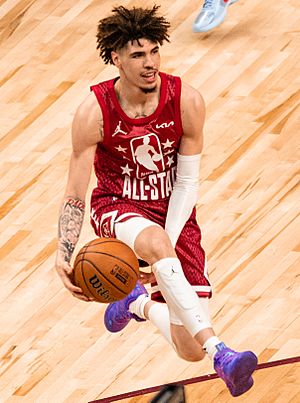
On November 18, 2020, the Hornets picked LaMelo Ball as the third overall pick in the 2020 NBA draft. They also got Gordon Hayward in a trade. The Hornets finished the 2020–21 NBA season 10th in the East with a 33–39 record. On June 16, 2021, LaMelo Ball won the 2020–21 NBA Rookie of the Year award. He was the third player in team history to win it.
On February 7, 2022, LaMelo Ball was chosen for his first NBA All-Star Game. The Hornets made the play-in tournament but lost to the Atlanta Hawks. On April 22, 2022, the Hornets fired head coach James Borrego. The team finished the 2021–22 NBA season with 43 wins and 39 losses.
On June 24, 2022, Steve Clifford returned as the Hornets' head coach. They also drafted Mark Williams and signed Dennis Smith Jr..
During the 2022–23 NBA season, many players were injured. The team finished with a 27–55 record. LaMelo Ball only played 36 games. However, Mark Williams showed great potential.
Because of their record, the Hornets got the second pick in the 2023 NBA draft. They used it to pick Brandon Miller.
On June 16, 2023, Michael Jordan announced he was selling most of his team ownership. The NBA approved the sale on July 23, 2023.
On April 3, 2024, Steve Clifford announced he would move into an advisor role. He finished as the Hornets' all-time win leader for a coach. On May 9, 2024, Charles Lee was announced as the new head coach.
Brandon Miller had a good first season, averaging 17 points per game. He finished third in Rookie of the Year voting. LaMelo Ball and Mark Williams both missed many games due to injuries. The team traded Terry Rozier and PJ Washington for other players like Kyle Lowry and Grant Williams. After the season, former player Kemba Walker was hired as a player enhancement coach.
Logos and Uniforms
Team Logos
The original Hornets logo featured a teal and purple hornet dribbling a basketball. The words 'Charlotte Hornets' were curved around it.
The Bobcats' first logo (2004–2012) showed a snarling orange bobcat. Later, in 2012, the bobcat became gray, and Carolina blue was added to the logo.
Charlotte's second Hornets logo (since 2014) shows a teal and purple hornet facing forward. The words 'Charlotte Hornets' are on its body. It has wings and a stinger, with a basketball pattern.
Team Uniforms
Original Hornets Uniforms
The first Hornets uniforms were designed by Alexander Julian. They were teal and purple with pin stripes. Both home and away jerseys said "Charlotte." Home jerseys were white, and away jerseys were teal.
In 1994, a purple alternate uniform was added. From 1997 to 2002, small changes were made, like moving the mascot logo and adding side stripes.
Bobcats Uniforms
The Bobcats' first home jerseys were white with "Bobcats" in orange. Away jerseys were orange with "Charlotte" in white. They also had a blue alternate jersey. Special "Racing Day" blue uniforms were used to honor Charlotte's NASCAR fans.
For the 2009–10 season, the Bobcats changed their uniforms. They had silver pinstripes, like the original Hornets. Home uniforms were white with "Bobcats" in blue. Road uniforms were blue with "Charlotte" in white.
In 2012, the Bobcats changed their uniforms again. They used less orange. The white home uniforms said 'Cats' in navy and Carolina blue. The navy away uniforms said 'Charlotte' in white and Carolina blue. These uniforms looked a bit like the Dallas Mavericks' uniforms.
Revived Hornets Uniforms
The new Hornets uniforms were shown on June 19, 2014. They had white home and purple road uniforms with "Hornets" on the chest. A teal alternate uniform with "Charlotte" on the chest was also introduced.
In 2015, a black sleeved alternate uniform was added, featuring their "Buzz City" nickname.
Since the 2017–18 season, Nike's Air Jordan brand makes the Hornets' uniforms. The white "Association" and teal "Icon" uniforms have "Hornets" on the front. The purple "Statement" uniform has "Charlotte" on the front.
The purple "Statement" uniforms were updated in 2019. They featured "CHA" (for Charlotte) in bold white letters. In 2020, new uniforms with double pinstripes, like the 1997–2002 jerseys, were unveiled.
Before the 2022–23 season, the purple "Statement" uniform was changed again. It brought back the "Hornets" wordmark.
The Hornets' "City" uniforms often celebrate Charlotte's history. The 2020–21 "City" uniform honored the city's history with gold mining, using a mint color. The 2022–23 "City" uniform was black with "CLT" (Charlotte's airport code) in gold.
For the 2021–22 season, the "City" uniform mixed different past designs. It had the cursive "Charlotte" wordmark and pinstripes.
In the 2023–24 season, the "City" uniform combined "Buzz City" and the gold mining themes. It was teal with gold and mint colors.
The "Classic" uniforms bring back old Hornets pinstriped designs. Teal, white, and purple versions have been used to celebrate anniversaries.
Performance Record
Here are the last five seasons for the Hornets.
Note: GP = Games played, W = Wins, L = Losses, W–L% = Winning percentage
| Season | GP | W | L | W–L% | Finish | Playoffs |
| 2020–21 | 72 | 33 | 39 | .458 | 4th, Southeast | Did not qualify |
| 2021–22 | 82 | 43 | 39 | .524 | 3rd, Southeast | Did not qualify |
| 2022–23 | 82 | 27 | 55 | .329 | 5th, Southeast | Did not qualify |
| 2023–24 | 82 | 21 | 61 | .256 | 4th, Southeast | Did not qualify |
| 2024–25 | 82 | 19 | 63 | .232 | 4th, Southeast | Did not qualify |
Arenas
- Charlotte Coliseum (1988–2002, 2004–2005)
- Spectrum Center (2005–present) (also known as Charlotte Bobcats Arena and Time Warner Cable Arena)
The Hornets played their first 15 seasons at the Charlotte Coliseum, which fans called "The Hive." It was the largest basketball arena in the league. The Coliseum sold out 371 games in a row! The Hornets led the NBA in attendance for eight of their first nine seasons.
When the team returned as the Bobcats, they played in the Coliseum for the 2004–05 NBA season. This was while their new arena, the Charlotte Bobcats Arena, was being built. After the new arena was finished, the old Coliseum closed.
In 2008, the Bobcats' new arena was renamed Time Warner Cable Arena. When the Hornets name returned, "The Hive" nickname also came back for the arena. In 2016, the arena was renamed the Spectrum Center.
The Hornets practice at the Novant Health Training Center, which is inside the Spectrum Center.
Team Personnel
Current Roster
Head Coaches
Team Records and Awards
Team Leaders (Regular Season)
Bold means the player is still with the team. Italic means the player is still active but not with the team.
Points Scored (as of the end of the 2024–25 season)
- Kemba Walker (12,009)
- Dell Curry (9,839)
- Gerald Wallace (7,437)
- Larry Johnson (7,405)
- Miles Bridges (6,642)
- Terry Rozier (5,974)
- Glen Rice (5,651)
- Muggsy Bogues (5,531)
- Raymond Felton (5,311)
- David Wesley (5,241)
- LaMelo Ball (4,859)
- Gerald Henderson Jr. (4,701)
- Emeka Okafor (4,630)
- Alonzo Mourning (4,569)
- Kendall Gill (4,159)
- Marvin Williams (4,149)
- Cody Zeller (4,062)
- P. J. Washington (3,946)
- Michael Kidd-Gilchrist (3,738)
- Nicolas Batum (3,728)
Other Statistics (as of the end of the 2024–25 season)
| Most Minutes Played | |
|---|---|
| Player | Minutes |
| Kemba Walker | 20,607 |
| Muggsy Bogues | 19,768 |
| Dell Curry | 17,613 |
| Gerald Wallace | 16,718 |
| Larry Johnson | 14,635 |
| Raymond Felton | 13,939 |
| Miles Bridges | 13,070 |
| David Wesley | 13,046 |
| Marvin Williams | 11,615 |
| Emeka Okafor | 11,212 |
| Most Rebounds | |
|---|---|
| Player | Rebounds |
| Emeka Okafor | 3,516 |
| Larry Johnson | 3,479 |
| Gerald Wallace | 3,398 |
| Cody Zeller | 2,824 |
| Miles Bridges | 2,627 |
| Bismack Biyombo | 2,625 |
| Michael Kidd-Gilchrist | 2,388 |
| Anthony Mason | 2,354 |
| Kemba Walker | 2,317 |
| Marvin Williams | 2,293 |
| Most Assists | |
|---|---|
| Player | Assists |
| Muggsy Bogues | 5,557 |
| Kemba Walker | 3,308 |
| Raymond Felton | 2,573 |
| David Wesley | 1,911 |
| LaMelo Ball | 1,710 |
| Baron Davis | 1,605 |
| Larry Johnson | 1,553 |
| Nicolas Batum | 1,521 |
| Brevin Knight | 1,497 |
| Dell Curry | 1,429 |
| Most Steals | |
|---|---|
| Player | Steals |
| Muggsy Bogues | 1,067 |
| Gerald Wallace | 827 |
| Kemba Walker | 799 |
| Dell Curry | 747 |
| Raymond Felton | 565 |
| David Wesley | 551 |
| Baron Davis | 439 |
| Kendall Gill | 398 |
| Brevin Knight | 355 |
| Terry Rozier | 347 |
| Most Blocks | |
|---|---|
| Player | Blocks |
| Alonzo Mourning | 684 |
| Emeka Okafor | 621 |
| Bismack Biyombo | 607 |
| Gerald Wallace | 531 |
| Elden Campbell | 484 |
| Cody Zeller | 315 |
| Michael Kidd-Gilchrist | 301 |
| P. J. Washington | 295 |
| Miles Bridges | 294 |
| Marvin Williams | 287 |
| Most Three-Pointers Made | |
|---|---|
| Player | 3-pointers made |
| Kemba Walker | 1,283 |
| Dell Curry | 929 |
| Terry Rozier | 864 |
| Miles Bridges | 732 |
| LaMelo Ball | 705 |
| Marvin Williams | 681 |
| P. J. Washington | 536 |
| Glen Rice | 508 |
| Nicolas Batum | 496 |
| Devonte' Graham | 431 |
Individual Awards
All-Rookie First Team
- Kendall Gill – 1991
- Larry Johnson – 1992
- Alonzo Mourning – 1993
- Emeka Okafor – 2005
- LaMelo Ball – 2021
- Brandon Miller – 2024
All-Rookie Second Team
- Rex Chapman – 1989
- J. R. Reid – 1990
- Raymond Felton – 2006
- Adam Morrison – 2007
- Walter Herrmann – 2007
- D. J. Augustin – 2009
- Michael Kidd-Gilchrist – 2013
- Cody Zeller – 2014
- P. J. Washington – 2020
All-NBA Second Team
- Larry Johnson – 1993
- Glen Rice – 1997
All-NBA Third Team
- Anthony Mason – 1997
- Glen Rice – 1998
- Eddie Jones – 2000
- Al Jefferson – 2014
- Kemba Walker – 2019
All-Defensive First Team
- Gerald Wallace – 2010
All-Defensive Second Team
- Anthony Mason – 1997
- Eddie Jones – 1999, 2000
- P. J. Brown – 2001
Rookie of the Year
- Larry Johnson – 1992
- Emeka Okafor – 2005
- LaMelo Ball – 2021
Sixth Man of the Year
- Dell Curry – 1994
Executive of the Year
- Bob Bass – 1997
NBA All-Star Weekend
- Larry Johnson – 1993, 1995
- Alonzo Mourning – 1994, 1995
- Glen Rice – 1996, 1997, 1998
- Eddie Jones – 2000
- Baron Davis – 2002
- Gerald Wallace – 2010
- Kemba Walker – 2017, 2018, 2019
- LaMelo Ball – 2022
All-Star Most Valuable Player
- Glen Rice – 1997
Retired Numbers
| Charlotte Hornets Retired Numbers | ||||
| No. | Player | Position | Years with Team | Date Retired |
|---|---|---|---|---|
| 13 | Bobby Phills | G | 1997–2000 | February 9, 2000 |
- The Charlotte Hornets retired Bobby Phills' number 13 after he passed away in a car accident in 2000. His jersey was displayed in the arena. When the team moved, it went to New Orleans. On November 1, 2014, his jersey returned to Charlotte and now hangs in the Spectrum Center.
- The NBA retired Bill Russell's No. 6 for all teams on August 11, 2022.
Basketball Hall of Famers
| Charlotte Hornets Hall of Famers | ||||
|---|---|---|---|---|
| Players | ||||
| No. | Name | Position | Years with Team | Inducted |
| 00 | Robert Parish | C | 1994–1996 | 2003 |
| 33 | Alonzo Mourning | C/F | 1992–1995 | 2014 |
| 12 | Vlade Divac | C | 1996–1998 | 2019 |
| 9 | Tony Parker | G | 2018–2019 | 2023 |
| Coaches | ||||
| Name | Position | Years with Team | Inducted | |
| Larry Brown | Head coach | 2008–2010 | 2002 | |
FIBA Hall of Famers
| Charlotte Hornets Hall of Famers | ||||
|---|---|---|---|---|
| Players | ||||
| No. | Name | Position | Years with Team | Inducted |
| 12 | Vlade Divac | C | 1996–1998 | 2010 |
| 33 | Alonzo Mourning | C/F | 1992–1995 | 2019 |
Mascot and Cheerleaders
Hugo The Hornet is the team's current mascot. When the Hornets name returned, Hugo was announced to come back as the mascot for the 2014–15 NBA season.
From 2004 to 2014, Rufus D. Lynx was the mascot for the Bobcats. His name came from the scientific name for a bobcat, Lynx rufus. Rufus D. Lynx was retired when the Hornets name returned. The updated Hugo was shown to the public on June 5, 2014.
The Hornets also have an official cheerleading squad called the Charlotte Honey Bees. They perform dances during games and help in the community. When the team was the Bobcats, the cheerleaders were called the Lady Cats.
Media Coverage
The Hornets games are shown on Bally Sports Southeast. Eric Collins and Dell Curry are the main announcers.
The team's radio station is WFNZ-FM.
See also
 In Spanish: Charlotte Hornets para niños
In Spanish: Charlotte Hornets para niños


